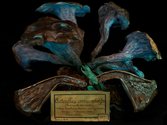John Hurrell – 5 October, 2011
There is a chromatic otherworldly sweetness that would appeal to children, a perverse joke on Pardington's part seeing many of the fungi represented here are notoriously toxic. These images are like grottos, shaded little spaces that are worlds within themselves where fairies and wee wood folk might dwell. You can imagine centipedes and spiders living there too.
This is a new series of photographs from Fiona Pardington, and like her very popular images of nineteenth century phrenological casts (made during d’Urville’s explorations of the Pacific) we see more plaster casts from French museums - but this time it’s fungi. The busts were made in the 1830s, and the specimens for these facsimiles of mushrooms and toadstools, made by the mycology author and illustrator Jean-Baptiste Barla (1817-1896) several decades later, came from various southern provinces of France. Intended as aids for identification and classification, the replicas are important because many fungi species are delicious and ubiquitous, while other similar looking ones are deadly. They became part of the collection of the museum of Nice, of which Barla was founding director. That is where Pardington found them in April this year.
Pardington’s images look as if they’re illuminated by small theatre spots, a dramatic spectral effect (somewhat corny) from synthetic reds, greens, oranges and yellows. Surprisingly this quality comes from the artist’s application by hand of thin coloured inks onto the photographic paper. The plaster casts glow because of the dark velvety background they’re set off against.
We can detect shiny reflections on the surfaces of the old, dry and almost worn plaster. The gnarled and knobby forms are like skin-stretched, sinewy human body parts - chiefly fingers, penises, toes and bony arms. Some are draped in green ribbons bearing text, while others rest in fibrous vegetable matter. A few of the bigger mushrooms are sliced in half so they can be seen in cross-section. Other much smaller puffballs are peeled open to expose multiple perforations and internal netlike passageways.
Others still, smaller images, reveal toadstools sprouting out of pine cones. Some forms look like snake heads, others like the ribs of rotting sheep. In a few Pardington has rearranged elements using Photoshop and in most she has improvised with the colour. The original curling tatty labels - often with added handwriting, Latin names, locations and dates - remain the same. They are just as intriguing as the oddly angular leaning organic growths behind them.
This theatricality and lighting is really striking. There is a chromatic otherworldly sweetness that would appeal to children, a perverse joke on Pardington’s part seeing many of the fungi represented here are notoriously toxic. These images are like grottos, shaded little spaces that are worlds within themselves where fairies and wee wood folk might dwell. However because they also look dark and damp (you can almost smell the moisture and rotting humus) there is a pervading creepiness. You can imagine centipedes and spiders living there too.
The late 1830s phrenological busts Pardington documented mesmerised because you wondered about the many individuals who left those bodily traces. (Some, like Dumont d’Urville and his family, didn’t live much longer, incinerated in France’s first ever train smash at Versailles not long after they returned to Europe.) The fungi images make you think about taxonomy, but unlike the busts, not so much about history and individuals - apart from Barla and his collection. They engage less with the world and are more escapist. Nevertheless a fascinating retreat.
John Hurrell
Recent Comments
Andrew Paul Wood
Ahem. http://tworooms.co.nz/exhibitions/pardington-2011/
Andrew Paul Wood
I believe the colour tweaks are Photoshop too.







 Advertising in this column
Advertising in this column Two Rooms presents a program of residencies and projects
Two Rooms presents a program of residencies and projects



This Discussion has 2 comments.
Comment
Andrew Paul Wood, 10:10 p.m. 27 October, 2011 #
I believe the colour tweaks are Photoshop too.
Andrew Paul Wood, 10:12 p.m. 27 October, 2011 #
Ahem.
http://tworooms.co.nz/exhibitions/pardington-2011/
Participate
Register to Participate.
Sign in
Sign in to an existing account.